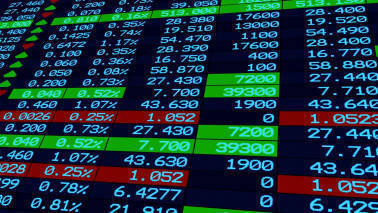- Gold surges sharply after being range bound for two years
- Triggered by growth worries, geopolitical tensions and lower interest rates
- Provides a cue for asset-allocation; central bank's inclination for diversification in reserves
- China's move for gold buying and a simultaneous offloading of US treasury needs a close watch
Gold prices have surged to a six-year high. Directionally, it is not just gold but all the proxies of safe haven assets have moved up recently – including Swiss franc, Japanese yen and bonds. The recent jump has put the spotlight on an asset class which is relatively less volatile.
Dollar-gold inverse relation
A cursory look at the long term price trend would suggest that uptrend in gold price is a reflection of dollar weakness. As internationally gold is traded/quoted in dollar terms so when dollar appreciates vs. other currencies, gold prices decline in dollar terms. Gold becomes more expensive in terms of other currencies, thereby adversely impacting demand. Inverse is also true and recent weakness in dollar is supporting gold prices.
Chart: Year on year changes in Gold prices vs. trade weighted dollar

Source: Moneycontrol Research, fred.stlouisfed.org
Macro context – half a decade back
However, to understand this phenomenon in a more granular level let us step back. Last time when gold traded at this levels, global economy was seeing first signs of a major shift in monetary policy regime in the year 2013 – that phase was also called taper tantrum. In 2013, the then Federal Reserve Chair Ben Bernanke hinted at a reduction in quantitative stimulus program.
While in the interim, stimulus fed asset classes were shaken, broader theme for the asset class re-allocation had already started playing. A shift from gold as an asset class towards risky- asset classes such as equities took place which generally outperform when economy and inflation picks up.
This was further boosted when Federal Reserve formally embarked upon interest rate hike cycle on 16 December, 2015. Start of the US interest rate hike cycle was a signal that US economy is way past recession gloom and investors should lap up to asset classes which outperform in an interest rate rising scenario.
To put it other way round, logic behind asset re-allocation rested on the fact that gold is an idle asset which has a carrying cost attached to it. In a rising interest rate environment it losses value and hence makes sense to allocate same money to other asset classes such as equities which can potentially appreciate and also provide dividends.
Shifting sands
In last nine months or so global macroeconomic context has turned fragile. Fed which was on course for a 2-3 rate hikes in 2019 is now looking at a possibility of 1-2 rate cuts in the remaining part of the year. ECB, which was earlier set for interest rate normalization is talking about a potential stimulus. Global trade outlook has deteriorated amid US-China trade war. Inflation in advanced economies is way behind the target 2 percent level. Further, to add to geopolitical flash points, US-Iran tussle is apparently moving from economic sanctions to a possible military confrontation. In short, global growth uncertainty has intensified recently.
As a result, the US treasury 10-year yield has declined by about 120 bps from its November 2018 highs. So one way to look at gold prices is that it is now factoring in global uncertainties which was incrementally captured by US 10 year treasury over the period.
Central banks diversification
Further, globally, few central banks have resorted to buying gold as part of diversifying their reserve base. In last four years Russia and China have increased their holding by 75% and 79% respectively. As per World Gold Council, almost one fifth of central banks signaled their intention to increase gold purchases over the next 12 months.
This also signals in a way that dollar is losing its status as reserve currency. Majors EMs such as Russia and China are increasingly resorting to trade in local currency. Further, there is a growing risk that China may accelerate the offloading of its share in US treasury. It’s noteworthy that foreign ownership of US public debt is of the order of $6.43 trillion, of which China holds $1.11 trillion – this is already 7 percent lower than the level in June’18. On a longer term, mushrooming of crypto currency and digital currency also doesn’t bode well for the faith in dollar as a global trading currency.
Graph: US Federal debt ownership

Source: fred.stlouisfed.org
Graph: Quarterly official gold reserves

As of 30th April’19
Sources: Central Banks, ICE Benchmark Administration, International Monetary Fund, World Gold Council
Coming back to fund flows, there have also been a spurt in inflows for US and Europe based ETFs recently. If we look at gold demand by different sectors, investment demand waxes and wanes as per economic cycle. Annual 2018 data suggests investors were increasingly getting positioned with higher investment in gold.
Chart: Gold demand (in %) share of sectors

Source: Moneycontrol Research, WGC
What’s in for investors?
Gold prices have been moving in a broad price range ($1200 to $1350 per ounce) for last two years. At the lower end it was helped by the fact that average cost of gold production is about $1200, and hence there is a limited chance of prices going below it. On the upside, gold price has broken multiyear resistance level.
One should also be cognizant of preemptive measures taken by central banks and likelihood that US-China trade war can resolve before it inflicts irreparable damage to global economy. In this context, key event to watch out would be Xi-Trump meet on the sidelines of G-20 meeting (28-29 June). Hence, investors who want to consider gold for portfolio diversification may have to wait for lower levels.
Adds to macro pain
Coming to other macro implication, this is an added concern for India's rising current account deficit. Of late, there has been a surge in gold imports growth albeit on a soft base of last year. Respite here could be expected from weaker demand for gold jewellery in near term (off-season) before the festive season in Oct-Nov.
Table: Import statistics

(Disclaimer: Moneycontrol Research analysts do not hold positions in the companies discussed here)
India Union Budget 2019: What does Finance Minister Nirmala Sitharaman have up her sleeve? Click here for top and latest Budget news, views and analyses.


















